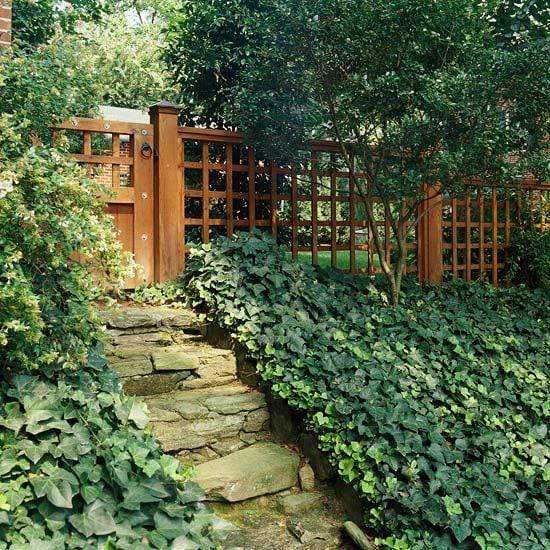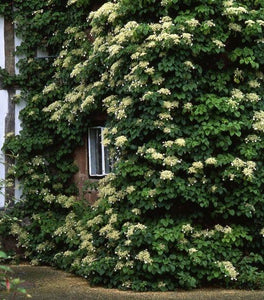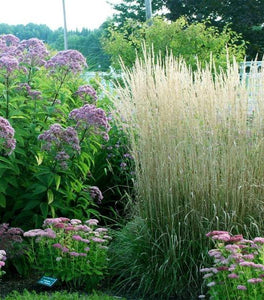
Images Depict Mature Plants
English Ivy for Sale Online
English Ivy (hedera helix) makes a thick ground cover that chokes out weeds and covers bare spots in vibrant green color. Its lovely green leaves beautifully brighten the winter landscape with evergreen vines that rarely, if ever, burn. It is a useful plant for erosion control on slopes.
It is fast-growing and has a widespread growth habit, making it perfect for creating a privacy screen or romantic nook when grown on a fence or trellis. Due to their aerial root hairs, these plants grow up to 80 feet tall if supported by larger trees and left unpruned. They have gone on to cover many houses across Europe, giving it its final nickname of European Ivy.

| Hardiness Zone: | 5-11 |
|---|---|
| Mature Height: | 4 to 6 Inches on the ground |
| Mature Width: | 6 to 7 Feet as a groundcover |
| Classification: | Perennial groundcover |
| Sunlight: | Full sun to full shade |
| Habit: | Spreading |
| Spacing: | Plant 12 Inches apart when planting as a ground-cover |
| Flower Color: | Inconspicuous |
| Flowering Season: | April to July |
| Foliage: | Vibrant green |
| Soil Condition: | Average well-draining |
| Water Requirements: | Water well until established |
| Uses: | Extremely attractive when used as a ground cover in the mixed shade border, mass planting as a groundcover deer resistant, tolerates heavy shade |
How to Care for English Ivy
Before you buy a English Ivy, make sure to read about the recommended care instructions to keep this plant healthy and flourishing.
How do I plant an English Ivy Plant?
We suggest when planting your newly purchased English Ivy plants that you dig a hole twice as wide as the root system but not deeper. The most common cause of plant death after transplanting is planting the new plant to deep. English Ivy is sold and shipped in plugs so planting is a breeze. Gently remove the plant plugs from their containers, using a pencil or stick to push them up from the bottom. Break up the soil just a little at the bottom and place in the hole, firmly filling in the hole with the original soil. Give your new plants a good watering to allow the roots to settle.
How do I water English Ivy?
After backfilling and lightly compacting the 50/50 mix of existing soil and compost give the English Ivy a good deep watering. This is not to be rushed. Most of the water you put on the plant at first will run away from the plant until the soil is soaked. A general rule of thumb is to count to 5 for every one gallon of pot size. For example, a one-gallon pot would be watered until you count to 5 a three-gallon pot would be 15 and so on. Check the plant daily for the first week or so and then every other day thereafter. Water using the counting method for the first few weeks. English Ivy can be watered well with a sprinkler when planting as a groundcover as they are shallow-rooted. Keep in mind that since they are shallow-rooted they will not have access to moisture deep in the soil until established.
How do I fertilize English Ivy?
Feeding your plants is probably the single most forgotten part of growing healthy long-lasting plants. We recommend feeding your English Ivy in the very early spring and again in mid-summer after all new growth has hardened off. Bio-tone starter fertilizer is the best product to use at the time of planting. Our ideal fertilizer schedule for you to use is as follows. Apply an early spring fertilizer with a product such as Espoma Flower-tone at the recommended rate this will give the plant a boost of nitrogen and potash that will be needed for healthy foliage and stem growth. Follow this up with another early summer application of Espoma Flower-Tone, this will again provide the necessary nutrients to promote a flush of beautiful foliage. Espoma products are easy to use, just sprinkle around the base of the plant and water it in. Be careful with products such as miracle-grow as these products can burn newly planted plants when not used at the recommended rates. Slow-release fertilizer can help prevent rapid soft growth that is vulnerable to diseases and insects.
How do I mulch English Ivy?
We highly recommend that you mulch your English Ivy with either a ground hardwood mulch or a ground cypress mulch depending on your local availability. Any type of mulch will do but cypress or hardwood mulch will be of a higher quality and provide better nutrition overall as they breakdown. Mulching helps to keep weeds away which will compete with your new investment for water and nutrients. A 2 to 3-inch layer of mulch is sufficient but remember to take care not to cover any part of the stem of the plant with mulch. It's better to leave a one-inch gap of space between the mulch and the stem or base of the plant. English Ivy roots where the stems touch the ground so eventually the need for mulch will be less and less as the plants start to form a mat.















